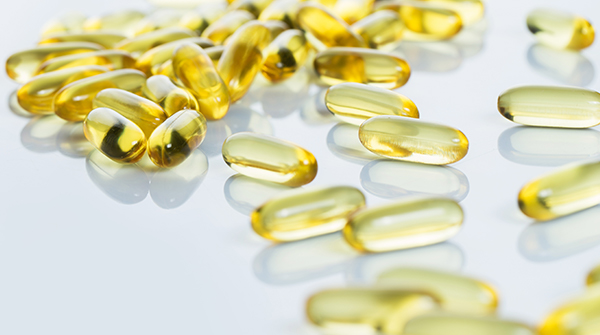Learn About Omega-3 Fatty Acids
 There are two essential fatty acids we must get in our diet: linoleic acid, an omega-6 fatty acid, and alpha-linoleic acid, an omega-3 fatty acid. They make and maintain the membranes that surround all of our cells, regulate our immune and inflammatory responses, promote wound healing and healthy skin and hair, regulate metabolism, and support the structure and function of our brain, nervous system, eyes, and bones, particularly during fetal and early childhood development. Americans get far too much omega-6 in their diets because we eat so many processed foods. Too much omega-6 can cause excessive amounts of inflammation. Omega-3 fatty acids dial back inflammation. There are three omega-3 fatty acids you should be familiar with: ALA, EPA and DHA. ALA is found in walnuts, seeds, and green leafy vegetables. EPA and DHA can technically be synthesized in the body from ALA. However, humans can’t make EPA and DHA very efficiently from ALA. They are critical to the health of our cardiovascular system, brain, and eyes. They may even help protect us from depression. Fish are rich in EPA and DHA, pre-made and ready for our body to use—no conversion necessary.
There are two essential fatty acids we must get in our diet: linoleic acid, an omega-6 fatty acid, and alpha-linoleic acid, an omega-3 fatty acid. They make and maintain the membranes that surround all of our cells, regulate our immune and inflammatory responses, promote wound healing and healthy skin and hair, regulate metabolism, and support the structure and function of our brain, nervous system, eyes, and bones, particularly during fetal and early childhood development. Americans get far too much omega-6 in their diets because we eat so many processed foods. Too much omega-6 can cause excessive amounts of inflammation. Omega-3 fatty acids dial back inflammation. There are three omega-3 fatty acids you should be familiar with: ALA, EPA and DHA. ALA is found in walnuts, seeds, and green leafy vegetables. EPA and DHA can technically be synthesized in the body from ALA. However, humans can’t make EPA and DHA very efficiently from ALA. They are critical to the health of our cardiovascular system, brain, and eyes. They may even help protect us from depression. Fish are rich in EPA and DHA, pre-made and ready for our body to use—no conversion necessary.
You can also find them in omega-3-enriched eggs, wild game, grass-fed beef, and certain seaweeds. The American Heart Association recommends that healthy adults eat fish at least twice weekly. The Global Organization for EPA and DHA Omega-3s (GOED) recommends people consume 500 mg of EPA and DHA every day for general health, and higher quantities for specific life stages or health conditions. Most of the population consumes significantly less EPA and DHA than recommended.
Who Might Benefit: Anyone who doesn’t regularly consume fatty fish twice a week should supplement with fish oil. For most people, taking 400 to 800 mg of EPA and 200 to 500 mg of DHA per day, or three to four times per week, is probably sufficient.
A 2014 study compared four different types: concentrated triglycerides, ethyl ester, whole salmon, and krill. Hands down, the concentrated triglycerides (Nordic Naturals) resulted in the most significant rise in blood EPA and DHA.



